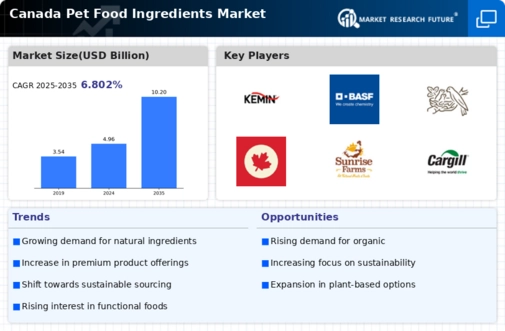The competitive dynamics within the pet food-ingredients market in Canada are characterized by a blend of innovation, strategic partnerships, and a focus on sustainability. Key players such as Nestle Purina PetCare (US), Mars Petcare (US), and Royal Canin (FR) are actively shaping the landscape through their operational strategies. Nestle Purina PetCare (US) emphasizes product innovation and sustainability, aiming to enhance its market share by introducing new, health-focused ingredients. Mars Petcare (US) is leveraging its extensive distribution network to expand its reach, while Royal Canin (FR) focuses on tailored nutrition solutions, catering to specific pet needs. Collectively, these strategies foster a competitive environment that prioritizes quality and consumer trust.
In terms of business tactics, companies are increasingly localizing manufacturing to reduce supply chain vulnerabilities and enhance responsiveness to market demands. The market structure appears moderately fragmented, with several players vying for dominance. However, the influence of major companies is substantial, as they set trends and standards that smaller entities often follow. This competitive structure encourages innovation and drives improvements in product offerings across the board.
In October 2025, Mars Petcare (US) announced a partnership with a leading Canadian agricultural firm to source locally produced ingredients, thereby enhancing its sustainability profile. This strategic move not only supports local economies but also aligns with growing consumer preferences for transparency and sustainability in pet food sourcing. Such initiatives are likely to strengthen Mars Petcare's brand loyalty and market position.
In September 2025, Nestle Purina PetCare (US) launched a new line of organic pet food products, reflecting a significant shift towards health-conscious offerings. This initiative is indicative of the increasing consumer demand for natural and organic ingredients, suggesting that Nestle Purina is keen to capture a segment of the market that prioritizes health and wellness for pets. The introduction of these products may enhance their competitive edge in a crowded marketplace.
In November 2025, Royal Canin (FR) unveiled a new digital platform aimed at educating pet owners about nutrition and health. This platform not only serves as a marketing tool but also positions Royal Canin as a thought leader in pet nutrition. By integrating technology into its customer engagement strategy, Royal Canin is likely to foster deeper connections with consumers, thereby enhancing brand loyalty and trust.
As of November 2025, the pet food-ingredients market is witnessing trends that emphasize digitalization, sustainability, and the integration of artificial intelligence in product development. Strategic alliances are increasingly shaping the competitive landscape, allowing companies to pool resources and expertise. Looking ahead, it appears that competitive differentiation will evolve from traditional price-based competition to a focus on innovation, technology, and supply chain reliability. This shift may redefine how companies engage with consumers, ultimately leading to a more dynamic and responsive market.





















Leave a Comment